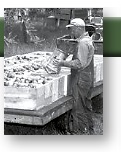Washington Apple Country History
The Great Northern Railroad - 3
James Hill continued to champion a seemingly endless series of prospective trades into the region. He encouraged lumber companies in Oregon, mining industries in Montana, cattle ranches throughout the plains, and apple farms in Washington. In 1887, construction crews arrived at one of the many cities which he had helped to establish: Great Falls, Montana.
Hill enticed scores of businesses move into the northwest territories, then granted to each a special low shipping rate. These nominal fares guaranteed that any company could send its products back east until such time as its business was firmly established. By developing both community and commerce, Hill was able to construct the Great Northern with extensions called "feeder" lines.
If coal was discovered a hundred miles north of the proposed train route, Hill built a feeder line to service the coal mine and its surrounding locale. If trees on a nearby mountain might be used for lumber, Hill would order construction of a feeder line to that mountain. A lumber company could then move in and obtain use of the railroad to ship its lumber to market. When valleys suitable for cattle ranching were located, Hill laid tracks for a feeder line to service those valleys. These branch lines guaranteed the promise of lucrative trade for the railroad.
By 1889, tracks for The Great Northern had reached the Rocky Mountains. Hill sent his surveyor, John F. Stevens, to canvass the region, to discern the lowest possible crossing through this vast mountain range. Stevens began to look for a specific passageway about which Lewis and Clark had written, but never found.
It was not until December that the young engineer finally located the Marias Pass which crosses the Contental Divide. Explorers had sought this corridor for decades; it now belonged to The Great Northern. The following year, Stevens helped to drive the railroad across a second pass, this one in the Cascade Mountains. That access now commemorates his name.
|






